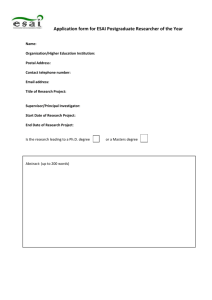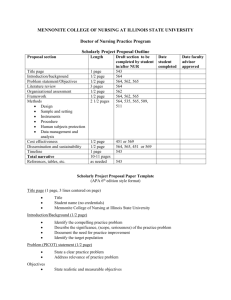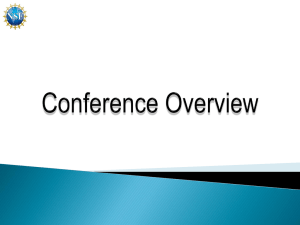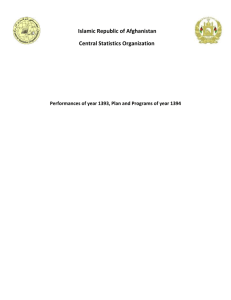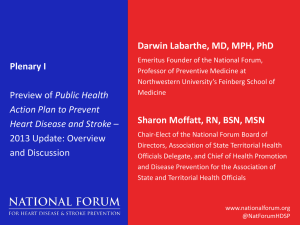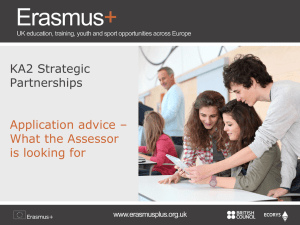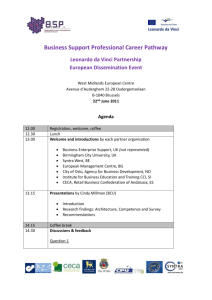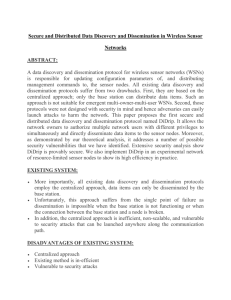Digas Dissemination Plan
advertisement
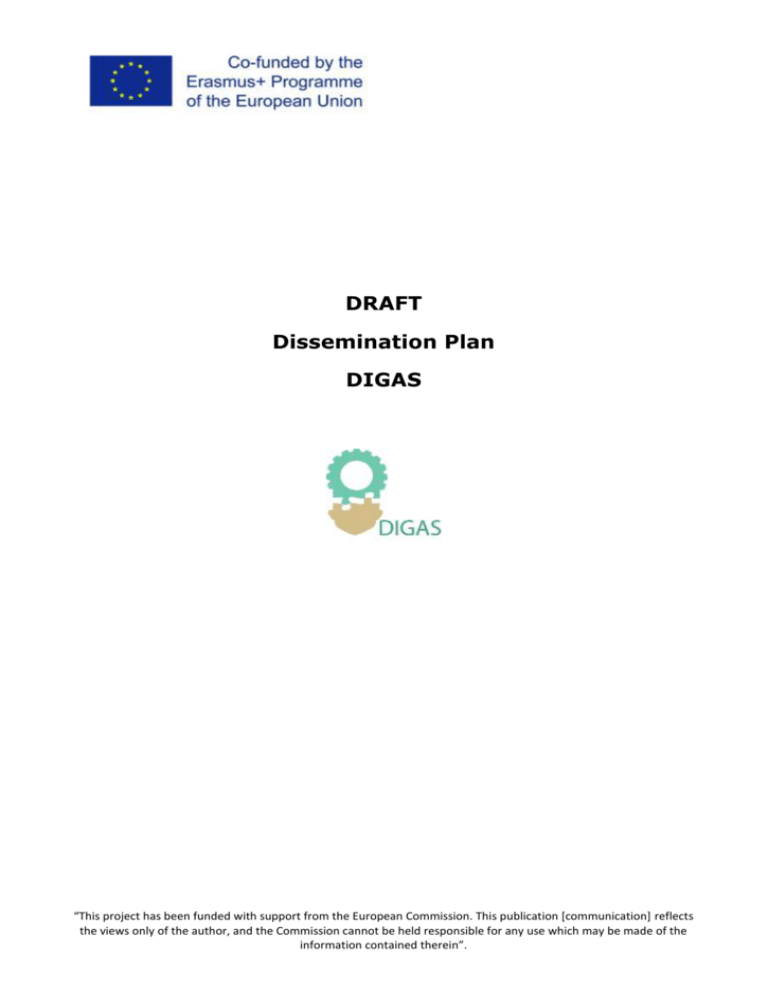
DRAFT Dissemination Plan DIGAS “This project has been funded with support from the European Commission. This publication [communication] reflects the views only of the author, and the Commission cannot be held responsible for any use which may be made of the information contained therein”. 1. Introduction All partners are expected to contribute to the dissemination activities. The dissemination plan starts with a definition of what dissemination is and thereafter describes what activities that need to be disseminated, who the stakeholders for the project are, as well as what dissemination channels and materials that are going to be used throughout the project. Finally, the dissemination plan contains a “schedule” for the dissemination activities. The dissemination plan will ensure that the partners within the project don’t use a single or limited approach, and that different forms of media are used for different target groups and different project outcomes. The dissemination plan will be updated on a regular basis and is therefore not a static document. During the course of the project, a list of all current and future dissemination activities will be maintained by all project partners along with associated material (report, articles, presentations, logo, poster, leaflet, etc.). These documents will be available at www.dropbox.com. After the first project year, an intermediate dissemination report will describe how commitments have been met related to the planning, the dissemination materials and the obtained results, with an overview of what will be done in the second part of the project. 2. What is dissemination? The European Commission defines dissemination as “the planned process of providing information on the quality, relevance and effectiveness of the results of programmes and initiatives to key actors. It occurs as and when the results of programmes and initiatives become available”. A project requires its potential stakeholders to be aware of its aims and objectives, after which they will become interested enough to wish a more detailed understanding. To create a basis for action, the “planned process of providing information” can be understood in three different ways: “Dissemination for awareness”: targeted towards stakeholders that can find it helpful to be aware if the activities and outcomes of the DIGAS project but do not require a detailed knowledge of our work. “Dissemination for understanding”: the aim is to make sure that stakeholders who are believed to benefit from the project have a deeper understanding of the project and the work carried out within the project. “Dissemination for action”: targeted stakeholders that need to be equipped with the right skills, knowledge and understanding of the project’s work in order to achieve real change. “This project has been funded with support from the European Commission. This publication [communication] reflects the views only of the author, and the Commission cannot be held responsible for any use which may be made of the information contained therein”. DIGAS integrates this argumentation in its dissemination approach by focusing on the AIDAmodel (Attention, Interest, Desire, and Action). The first part of the project will mainly focus on raising attention and interest for the project, while the second part will focus more on creating a desire and action to be involved in virtual placements. Successful dissemination produces change in people’s thoughts and actions. Influencing the relevant stakeholders is the objective of dissemination. Although it is worthwhile to disseminate results and experiences extensively and abundantly, the number of dissemination activities is not as essential as their end result. Ultimately the main motivation for dissemination, from the point of view of a project, is the achievement of sustainability. Sustainability can be envisaged as being composed of various elements or ingredients. They comprise visibility, networking, policy consensus, users’ feedback, funding (public or external), official recognition, competent staff, human resources commitment, and achieved sustainability of related output. Although the elements are not independent from each other and are difficult to measure in precise terms, a number of elements will need to be present if a given output is to be defined as sustainable. The type of necessary elements very much depends on the type of outcome. Dissemination is considered an essential part of the entire project, and not a separate matter to be taken care of at the end of the project only. It continues throughout the process. Dissemination is closely linked to the other work packages and especially to evaluation. Furthermore, dissemination within the DIGAS project is seen as a shared responsibility which falls to all the project partners. Each partner will take an active part in bringing into effect the measures set out in the dissemination plan. Therefore, it is important that each partner has a clear idea on their motivation to participate and the potential benefit produced by the project. The most important aspect of the dissemination of results is that the project partners feel they have achieved something valuable which is worth sharing with the larger public. 3. What do we want to disseminate? Dissemination will start at the very beginning of the project and will continue throughout the whole project duration. As stated earlier, the primarily focus at the beginning of the project will be to raise awareness and interest for the DIGAS project. The dissemination activities in the second part of the project will focus more on creating a desire and action in relation to the project, basically to create a desire within the relevant stakeholders to participate/offer (virtual) placements and real life assignments. During the second part of the project the dissemination activities will also focus on promoting the concrete outputs found in the first part of the project. Therefore, there is a distinction between the general project idea itself and the expected outcomes/outputs as to what we want to disseminate. 3.1 The project in a nutshell DIGAS is a new exciting project where Danish, Spanish, Belgian, Italian, Finnish, and Lithuanian markets are part of a strategic partnership. The project, however, is expected to expand to other European countries through the Space network. “This project has been funded with support from the European Commission. This publication [communication] reflects the views only of the author, and the Commission cannot be held responsible for any use which may be made of the information contained therein”. Graduates from studies with high unemployment rates throughout Europe are able to find new job possibilities in SMEs. This can, surely, be seen as a long needed boost for the European economy. The quality of the project is ensured by: Addressing foster citizens’ potential and simultaneously ensure employability. Students from humanities, theology, and philosophy that possess VET competences are going to be matched with SMEs thereby making a smooth entrance into the labor market. This happens by integrating the world of work in the last year and Unemployed graduates from humanities, theology, and philosophy gain VET competences are matched with SMEs thereby making an opening into the labor market. This happens by giving them intensive VET courses in cooperation with the world of work. The above is done in order to enhance the matching of skills and stimulate the competiveness of the SMEs globally. Furthermore the SMEs are then able to focus on new employee groups. The project addresses the following needs : In several member states youth unemployment, poverty, and inequality have increased. Employers fear that graduates are lacking skills and that the actual shortages of skills are going to be problematic in the developed nations due to the overall aging of the population. SMEs have problems to innovate, grow, meet quality standards and mismatches where not enough young people are trained at the needed levels and the young people that do have the right qualifications are not employable. Project goals regarding test methods • The qualitative skills mismatch occurs when companies give VET skills to graduates from studies with high unemployment rates (e.g. humanities, philosophy, theology etc.) “This project has been funded with support from the European Commission. This publication [communication] reflects the views only of the author, and the Commission cannot be held responsible for any use which may be made of the information contained therein”. • The quantitative mismatch where not enough young people are trained to be employable by giving the students in study programmes with high unemployment rates (eg. humanities, philosophy, theology etc.) the possibility of acquiring VET skills Both groups should be trained to enhance internalization in SMEs thereby making them better at competing on the global scene. To support and aid SMEs the new employee groups should be trained to assist SMEs in cultural understanding, develop strategies for internationalization, assess international market potential, and the expansion into foreign markets. Furthermore the understanding of business culture in different countries is vital for SMEs to expand and go global. Another positive side effect is to cross culture train unemployed graduates so they are able to assist the SMEs in conquering new markets. DIGAS is going to find ways of bringing the world of work to academia and fight the mismatch of competencies to the benefit of the SMEs. The knowledge of real life assignments is gained from the Nordplus and EU projects: NOBANET (lead ARCADA), EU-VIP and ProVip (partner Tietgen) To sum up it is important to increase the internationalization and competitiveness of the SMEs in order to achieve growth cross culturally. Other important aspects are the recognition of competences and fighting unemployment by integrating the world of work to the benefit of the local communities. You kill two birds with one stone by matching graduates from study areas with a high unemployment rate that are taught VET skills with SMEs that must enhance their understanding of business cultures in different countries in order to further their internalization strategies and international market potential. 3.2 Expected outcomes DIGAS will • Create new job possibilities in SMEs for graduates from study areas with high unemployment rate • Create synergies through cross sectorial cooperation between HEIs and VET (adult learning training centers) “This project has been funded with support from the European Commission. This publication [communication] reflects the views only of the author, and the Commission cannot be held responsible for any use which may be made of the information contained therein”. • Enhance stakeholder involvement in fighting mismatch of competencies • Find new ways of bringing world of work to academia • Use the integration of LLL in a vertical manner in fighting unemployement and mismatch of competencies to the benefit of SMEs DIGAS is intended to produce the following outcomes: • Innovative approaches to address skills mismatch with focus on building up European business and cross-cultural communication skills • New opportunities for unemployed graduates, by providing cross culture training making the unemployed graduates employable in a new field: SMEs going global • New ways of integrating real life assignments in training using knowledge gained from the Nordplus and EU projects: NOBANET (lead ARCADA), EU-VIP and ProVip (partner Tietgen) • New ways of combining HE teaching methodology with VET methodology to foster employability • Joint HE and VET adult learning module development in line with world of work's needs and expectations using of participatory approaches • New ways of internationalisation of VET by using ICT-based methodologies as virtual mobility tools developed for HE • Reinforced cooperation among partners from different countries and different sectors to the benefit of competence recognition • Further develop methodologies to fight unemployment via integrating world of work in education to the benefit of local communities • Improved practices to cater for the needs of unemployed groups dealing with cultural diversity • Increased international capacity and competitiveness in SMEs: improved internationalisation competences and internationalisation strategies in SMEs 4. Target audience Dissemination activities are targeted towards different stakeholder groups that are relevant for the DIGAS project. A stakeholder can be defined as “any group or individual who can affect, or be affected by the achievement of the projects objectives – or can influence these objectives”. The involvement of the different stakeholders will differ depending on what they want and what they need from the project, but also in relation to what the project needs from them. Therefore, the dissemination activities targeted towards the different stakeholder groups will “This project has been funded with support from the European Commission. This publication [communication] reflects the views only of the author, and the Commission cannot be held responsible for any use which may be made of the information contained therein”. differ. For some target groups, for example, it is sufficient with awareness raising activities, whilst more detailed actions are needed for others in order to gain their support or active participation. It is important to involve the different stakeholder groups so that they are not only presented with the outcomes of the project, but are involved in the creation of at least some of the outcomes. Their feedback is valuable and they will therefore be consulted throughout the project through stakeholder meetings, training workshops, symposia, and other events and meetings. The following stakeholder groups are identified for the dissemination activities of DIGAS: Businesses Businesses are the main target group for the DIGAS project. Supervisors of work placements within the companies and HR departments are of particular interest. It is important to involve the management of companies. The dissemination activities will be carried out through existing on- and offline events, publications, and social networks for businesses. The businesses will mainly be reached through the DIGAS stakeholder conference and the pilot activities. The dissemination activities will be practical, low threshold and focusing on good practices and benefits for companies since our experiences has shown that this strategy is most effective when it comes to targeting the business world. Training Centres/ institutions Training Centres/ institutions – training unemployed people -are another important target group, and especially those people within the institutions who are in direct contact with the unemployed graduates. It is also important to try and reach the management of these institutions/ centres so the people directly involved get the necessary support from their superiors in implementing new activities for unemployed graduates. The institutions/ centres that are partners in the project will be reached during the methodology and material development, and pilot activities. Staff members of other institutions/ centres are the direct target of our international conference. Higher education institutions Higher Education Institutions (HEIs) are another important target group, and especially those people within the institutions who are in training in areas with high unemployment, research, programme development, and lecturing. “This project has been funded with support from the European Commission. This publication [communication] reflects the views only of the author, and the Commission cannot be held responsible for any use which may be made of the information contained therein”. But, it is also important to try and reach the management of these institutions so the people directly involved get the necessary support from their superiors in implementing new activities the students in areas with high unemployment. The higher education institutions that are partners in the project will be reached during the research, material development and pilot activities. Staff members of other institutions are the direct target of our international conference. Jobcenters The jobcenters will be explicitly involved in the pilot activities, and will play an important role in the validation of the proposed initiatives and recommendations. They are of great importance because it is the unemployed graduates that will enjoy an improved learning experience that has been established in the full knowledge of what it takes to teach work in an SME. Unemployed will mainly be reached through the pilot activities where they will be able to test the methodologies and materials created in the project. 5. Dissemination Channels The participating institutions have some expertise in the dissemination of large scale projects at regional, national and international levels through developing and maintaining project websites and publicity materials, organising workshops, presenting at conferences and publishing widely. It is envisaged that international communication will be in English, but that local (especially institutional) communication will be preferably in a language that fits within the own internationalisation policy and strategy. Dissemination also uses a layered approach, involving first the partners within the network, then the institutions and organisations which the partners have direct links with, and finally, through publications, presentations and participation to EC initiated activities, the broader university and educational world inside and outside Europe. Activities to support the dissemination of project results include: 5.1 Project website Due to the increasing importance of the Internet, project websites are probably the most common dissemination tool and can guarantee a large visibility if promoted appropriately. Their advantages lie in the fact that they can contain a whole range of information and products, can be interactive and are therefore a ‘complete’ dissemination tool; their biggest disadvantage lies in the fact that they need updating and maintenance to be effective. Furthermore, our target audiences need to know it is there and have to be interested enough to visit the site in the first place. Once we have attracted them to the website, we have to find ways of ensuring they visit the site regularly. The website can be publicised via newsletter, events, brochures and mailing lists. We have to make sure that our site merits return visits by keeping it updated and by flagging interesting items on the homepage so that the user immediately can see that there is something new for them to look at. “This project has been funded with support from the European Commission. This publication [communication] reflects the views only of the author, and the Commission cannot be held responsible for any use which may be made of the information contained therein”. The main purpose of the DIGAS website is to create awareness and interest for the project amongst the relevant stakeholders. The stakeholders should always be updated on what is happening within the project and therefore the website will contain basic project information and will develop as the project goes along, thus serving as a record of the work done and ongoing work in the area. 5.2 Partner websites – European Commission websites In addition to the DIGAS website, all partners will publish short DIGAS descriptions on a visible place in their website, with a link to the DIGAS website. The project will also be announced at the: EVE platform of the European Commission (http://ec.europa.eu/dgs/education_culture/eve/) 5.3 Publications (reports, printed directories of outputs, journals, electronic journals, portals etc.) Publications are another traditional way of disseminating results, sometimes integrated with workshops/ conferences in order to cope with their main disadvantage: they are “cold”, not interactive ways of presenting results and can be ignored and forgotten if insufficient attention is attracted to the publication. An additional disadvantage is the time required to prepare effective publications. Some of the DIGAS partners have experience and interest in publishing in academic journals and at academic conferences, and also creating web publications. Project partners aim to publish joint papers in relevant academic journals (and books), both subject-based and of more generic interest, creating further interest in the initiative and enhancing its academic credibility amongst the scientific community. 5.4 Participation in conferences Participation in conferences probably constitutes the most traditional way to present results of innovative projects. They have the big disadvantage of being organised in a definite place and at a definite time, so they are not sufficient to guarantee long term access if not accompanied by publications (proceedings). If well organised, they can be a “warm” and interactive way to discuss results and possible future developments; their cost may be reduced to very little when organised within an institution. Findings from the DIGAS project will be presented at international conferences in the area of employment and education. Participation in conferences is also important in relation to creating awareness and interest for the project. 5.5 Workshops & seminars Workshops and seminars usually differ from conferences in that they are targeted at smaller groups of participants and involve a much higher and more active level of engagement. For example, a workshop might be organised as a "hands-on" session allowing participants to try out particular materials and approaches. Findings from DIGAS will be presented at those “smaller” (often also more “local”) events as well. 5.6 Stakeholder meetings “This project has been funded with support from the European Commission. This publication [communication] reflects the views only of the author, and the Commission cannot be held responsible for any use which may be made of the information contained therein”. In view of the transferability and to support the exploitation, stakeholder meetings will be organised which will involve higher education management or staff, company representatives, chambers of commerce or industry networks and student representatives with the aim of consultation on the project outcomes presented in view of future sustainable implementation in the mainstream activities of the organizations and institutions. It is very important that company representatives and/or industry networks are represented at these stakeholder meetings since dissemination towards of that stakeholder group is one of the core goals for the DIGAS project. 5.7 Networks and organisations The four networks that are directly involved within the DIGAS project consortium are of course well placed to disseminate project results within their own network. Through these four networks alone we have direct access to address the main target groups of DIGAS. The partner networks will include presentations, workshops and distribute leaflets about the project at their own events. With dissemination of information via these own communication channels those networks could facilitate access to project outcomes and ensure the availability of the course materials for their members all over Europe. Practically all partners also have links with and/or actively participate in international, national and regional, educational and enterprise networks, policy bodies, and other relevant membership organisations. Several of these networks will be contacted to actively promote the outputs of the project. It is envisaged that through this kind of natural relationships the DIGAS project results will find their way to a broader spectrum of institutes and stakeholders that could benefit from the project outcomes. Identifying existing networks and organisations and using existing channels can be one of the most effective methods of dissemination. Publishing articles in their newsletters, mailing through their extensive databases, participating in their conferences, seminars, workshops or other events, will facilitate access to project outcomes for their members all over Europe and will create more coverage for DIGAS. 6. Dissemination Materials The following dissemination materials will be produced to provide the target audiences with information, through the above defined dissemination activities: 6.1 Logo A logo will be designed and developed that will be used for all deliverables of the project. “This project has been funded with support from the European Commission. This publication [communication] reflects the views only of the author, and the Commission cannot be held responsible for any use which may be made of the information contained therein”. 6.2 Flyer The flyer will be distributed at conferences and other events where potential target users could be addressed. Special attention will be paid to pass on this information to the own newsletters of the institutions, in first instance the project partners and the networks their institution is member of, but in extension also to all members of the network partners in the project. 6.3 Presentation A general project presentation will be created that forms the basis for all project partners to present DIGAS to their audiences. A list of presentations given about DIGAS will be maintained on the project website, along with associated presentation materials. 6.4 Press releases In relation to the events organised within the DIGAS project press releases will be sent to the local press. The purpose is to create awareness and interest for the project. 7. Planning of dissemination activities In the very beginning of the project, the dissemination will mainly focus on raising awareness for the main project ideas and the targeted results. These dissemination activities for raising awareness will be continued throughout the whole project duration. As soon as the first results become available, the dissemination will more and more focus on interest and understanding. Our reports on the state-of-the-art and the scenario’s, the reports describing our experiences in the pilots as well as the events (meetings, workshops) will make sure that people can get a deeper understanding of the project’s work. Towards the end of the project the dissemination will focus on desire and action. The final event and final publication will equip interested people with the right skills and knowledge to be able to achieve real change in their own environment. Dissemination for action will however not only occur at the end of the project. The training workshops - organised in the middle of the project - will also serve that purpose. 8. Impact To ensure that our planned dissemination activities reach their target audiences and are helping us achieve our dissemination objectives, we will use a number of monitoring and evaluation methods throughout the project’s lifetime. The evaluation activities have two purposes: - To be formative i.e. to improve the dissemination activities - To be summative i.e. to collect feedback for the final report for the European Commission Both quantitative and qualitative evaluation methods will be looked at. Quantitative evaluation is about collecting statistics of the number of workshops/conference participants, participants, the number of flyers handed out etc. Qualitative evaluation consists of individual evaluation of each dissemination activity by means of dissemination reports that describe the date, time, activity performed, type and number of target groups that was reached and feedback from the participants. “This project has been funded with support from the European Commission. This publication [communication] reflects the views only of the author, and the Commission cannot be held responsible for any use which may be made of the information contained therein”. It is indeed not only important to just disseminate and promote the project ideas and outcomes. We should also think of measuring and recording the effectiveness of our dissemination efforts and therefore we will keep track of the impact we have had on our targeted end-users. Measuring the impact is not so much about knowing how many participants attended a certain workshop that was organised. More important to know is what kind of (positive or negative) feedback we received on the organisation and content of the workshop. Tietgen as project leader, will keep a record of everything that has happened by collecting the original dissemination materials (articles, presentations, etc.) and the dissemination reports that have to be submitted by each partner after a dissemination activity has taken place. These reports will be essential to gain insight in the impact of the project on the target groups. 9. Acknowledgement European Commission Project partners must clearly acknowledge the European Union's contribution in all publications or in conjunction with activities for which the grant is used. The following sentence needs to be used: "This project has been funded with support from the European Commission. This publication [communication] reflects the views only of the author, and the Commission cannot be held responsible for any use which may be made of the information contained therein." On each output or publication also the logo of the European Commission and ERASMUS+ has to be added. The logo, in different languages and different formats can be downloaded from following website: http://eacea.ec.europa.eu/about/eacea_logos_en.php “This project has been funded with support from the European Commission. This publication [communication] reflects the views only of the author, and the Commission cannot be held responsible for any use which may be made of the information contained therein”. References Suurla, R. et al. Methods and Tools for Effective Dissemination. A guide to the Dissemination of the Results of International Educational Projects. Published by IACEE in 1999. Harmsworth, S. et. al. Creating an Effective Dissemination Strategy. An Expanded Interactive Workbook for Educational Development Projects. (Bridging the Gap – Innovations Project 2001 - Higher Education Funding Council for England). Available at: http://www.innovations.ac.uk/btg/resources/publications/dissemination.pdf “Dissemination and exploitation of results of our programmes”, European Commission, Directorate-General for Education and Culture website, accessed at: http://ec.europa.eu/dgs/education_culture/valorisation/index_en.htm EU-VIP Dissemination plan “This project has been funded with support from the European Commission. This publication [communication] reflects the views only of the author, and the Commission cannot be held responsible for any use which may be made of the information contained therein”.
